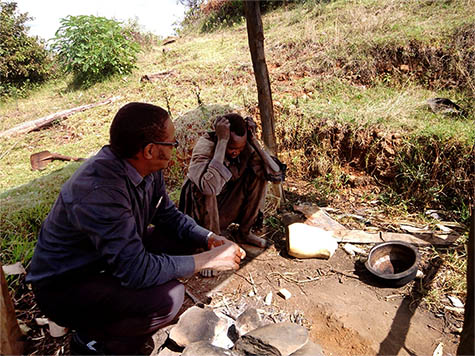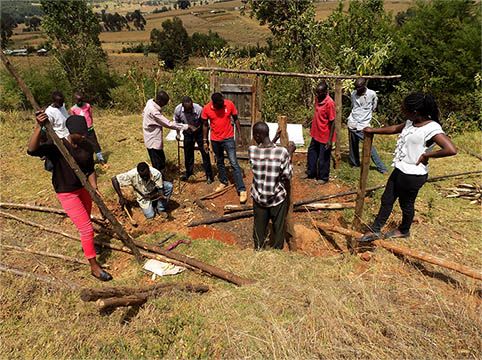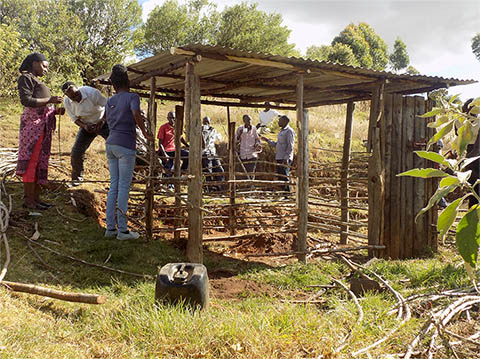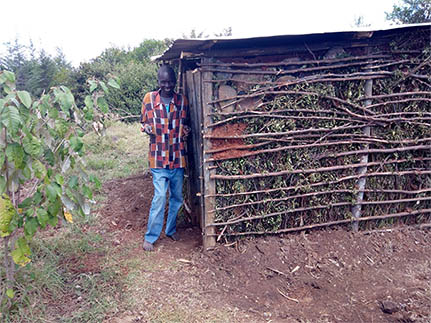Newsletter 1, April 2019
 In early October 2018, a local volunteer from the small town of Ol Jabet alerted St. Martin of a man living in the community with a severe mental health issue. The volunteer has joined St. Martin several years ago and worked for the Community Programme for Addiction and HIV/AIDS, which also runs the new project on mental health. She was, therefore, trained in spotting possible cases for the new mental health project.
In early October 2018, a local volunteer from the small town of Ol Jabet alerted St. Martin of a man living in the community with a severe mental health issue. The volunteer has joined St. Martin several years ago and worked for the Community Programme for Addiction and HIV/AIDS, which also runs the new project on mental health. She was, therefore, trained in spotting possible cases for the new mental health project.
When the team of St. Martin arrived at the site, it was greeted by a couple and their children. It turned out that this was the owner of the little farm the team was called to. The person with the mental health problem, let’s call him Paul, was the owner’s brother and was living with them. The couple told the team that Paul was brought here by his mother some years ago because she didn’t know how to handle his condition any more. In recent time his behaviour has become very erratic and they started to fear for themselves, but especially for their young daughters. Finally, the team called Paul – who at first refused to see people that he didn’t know. After some persuasion, he agreed to meet the visitors. But when he realized that the team of St. Martin contained also women he refused again, saying that he was not properly dressed. And indeed, after the women from St. Martin went back to the car, a half-naked man presented himself. The social workers talked to him and quickly understood that Paul needed medical assistance.
 At one point they asked if they could see where he slept and learned that Paul had his own little house behind the one of his brothers. So they went there – only there was no house. Just a dilapidated piece of roofing on four posts with a heap of random material that formed the outline of a small hut. Paul invited his guests into the hut, pointing out the imaginary door made up by a gap in the outline. Following Paul’s invitation, the social workers sat down on an equally imaginary chair – that was heavily infested with fleas. Later they learned that Paul used up his hut piece by piece to fuel his cooking fire and refused any help or intrusion by others.
At one point they asked if they could see where he slept and learned that Paul had his own little house behind the one of his brothers. So they went there – only there was no house. Just a dilapidated piece of roofing on four posts with a heap of random material that formed the outline of a small hut. Paul invited his guests into the hut, pointing out the imaginary door made up by a gap in the outline. Following Paul’s invitation, the social workers sat down on an equally imaginary chair – that was heavily infested with fleas. Later they learned that Paul used up his hut piece by piece to fuel his cooking fire and refused any help or intrusion by others.
The social workers returned to Nyahururu deeply touched and worried. Sleep was difficult to find this night, especially because there was heavy rainfall and Pau’s roof couldn’t really shelter him. After some discussions and arrangements, they returned and convinced Paul to see a doctor in the hospital. There he was diagnosed and received medication. Meanwhile, the social workers called for a meeting of the neighbours and the wider community. They explained the situation, that Paul was being cared for now, but he still needed a new house. They appealed on the good-will and solidarity of the community. And promptly, someone donated a piece of metal roofing, others building material or furniture. The following weekend all the neighbours brought their contribution to Paul’s place and built a new house, ready for Paul’s return.
 Today Paul is much better and very happy with his new house. He plans to add the outer mud-plaster layer when the rainy season starts. He is joking with the neighbours and helps them with small tasks by. And he even went visiting his aunt and contacted his mother. His brother’s family is very happy and relieved too. The wife said to the social workers: “You know, you may think that Paul was ill. But I was even more ill. By helping him you have healed me and my family too.”.
Today Paul is much better and very happy with his new house. He plans to add the outer mud-plaster layer when the rainy season starts. He is joking with the neighbours and helps them with small tasks by. And he even went visiting his aunt and contacted his mother. His brother’s family is very happy and relieved too. The wife said to the social workers: “You know, you may think that Paul was ill. But I was even more ill. By helping him you have healed me and my family too.”.
Only through community
St. Martin does not directly work with the vulnerable people in the community, such as those afflicted by disabilities, living with HIV/AIDS, or having a mental illness. The focus is on the ‘able’ people in the communities who have gifts, talents and resources. By involving and facilitating these people St. Martin indirectly cares for those who are vulnerable. Hence the motto of St. Martin: Only Through Community.
St. Martin is convinced that lasting solutions for problems of people in need can always be found by and within the community itself. The necessary resources are available and there are many people of goodwill that just need to be mobilized. St. Martin helps with the immediate needs and then works with the community to find a long term solution.
 An important part hereby paly the local volunteers. This network is made up of people, who have decided to freely give their time and energy for the community and for people in need. They can be farmers, housewives, shopkeepers, teachers, doctors, advocates etc. Depending on their talents and gifts volunteers can engage differently in the work of St. Martin. Most of them work in the community, in direct contact with people in need. For instance, they nurse AIDS patients at home or care for abandoned or abused children. Or they help to find people with mental illnesses for the new project. They also create awareness on the needs of vulnerable neighbours and promote solidarity by mobilizing people to provide assistance where there is an immediate need: for medicine, for food, or they give free professional services as doctors or lawyers. Or they collect building material and construct a small. home.
An important part hereby paly the local volunteers. This network is made up of people, who have decided to freely give their time and energy for the community and for people in need. They can be farmers, housewives, shopkeepers, teachers, doctors, advocates etc. Depending on their talents and gifts volunteers can engage differently in the work of St. Martin. Most of them work in the community, in direct contact with people in need. For instance, they nurse AIDS patients at home or care for abandoned or abused children. Or they help to find people with mental illnesses for the new project. They also create awareness on the needs of vulnerable neighbours and promote solidarity by mobilizing people to provide assistance where there is an immediate need: for medicine, for food, or they give free professional services as doctors or lawyers. Or they collect building material and construct a small. home.
My contribution
And where am I involved in all this? The story of Paul is a good example of how St. Martin is working. My tasks is it to help telling it and other stories to the public. For this, the stories need to written and prepared in a suitable form for the desired media, like for this newsletter for example. It’s thereby important that I am not the only one to do this, hence I’m also organising different workshops about communication, about how to write the stories or about how to take good pictures to accompany them.
wit kind regards
![]()
